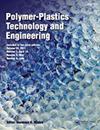Condensed Tannin-Based Polyurethane as Functional Modifier of PLA-Composites
Q2 Materials Science
引用次数: 13
Abstract
ABSTRACT Novel polylactic acid-based composites were prepared for the first time by melt-blending urethanization using bark polyflavonoids, and polymeric methyl diisocyanate. Rheological, morphological, structural, thermal, and mechanical properties were studied. Polymerization between polyflavonoids and isocyanate during the melt-blending was demonstrated by spectroscopy, confocal microscopy, and thermal analysis. Polyflavonoids improved the blend processability and affected the polylactic acid-crystallization, blend-urethanization, and flexural features. Polyphenols act as nucleating agent, and the effect was highly influenced by the polymeric methyl diisocyanate-charge, and the polyflavonoids-content. Low polymeric methyl diisocyanate-loading (10 wt%) degrades the elasticity modulus (E), while the highest polymeric (20 wt%) improved the miscibility between the polylactic acid polymer-matrix and the polyflavonoids. GRAPHICAL ABSTRACT缩合单宁基聚氨酯作为pla复合材料的功能改性剂
摘要以树皮总黄酮和聚合二异氰酸酯甲酯为原料,采用熔融共混脲烷化法制备了新型聚乳酸基复合材料。对其流变、形态、结构、热学和力学性能进行了研究。通过光谱、共聚焦显微镜和热分析证实了熔合过程中多黄酮和异氰酸酯之间的聚合。聚黄酮类化合物改善了共混物的加工性能,影响了聚乳酸结晶、共混脲化和弯曲性能。多酚类物质作为成核剂,其成核效果受聚合物二异氰酸酯含量和多黄酮含量的影响较大。低聚合物二异氰酸酯负载(10 wt%)降低弹性模量(E),而高聚合物负载(20 wt%)改善了聚乳酸聚合物基质与多黄酮类化合物之间的混溶性。图形抽象
本文章由计算机程序翻译,如有差异,请以英文原文为准。
求助全文
约1分钟内获得全文
求助全文
来源期刊

Polymer-Plastics Technology and Engineering
工程技术-高分子科学
CiteScore
1.71
自引率
0.00%
发文量
0
审稿时长
4 months
 求助内容:
求助内容: 应助结果提醒方式:
应助结果提醒方式:


